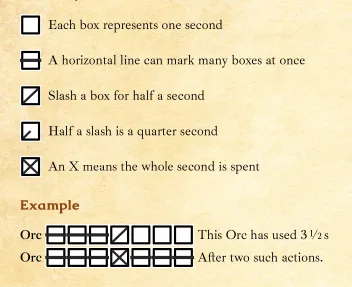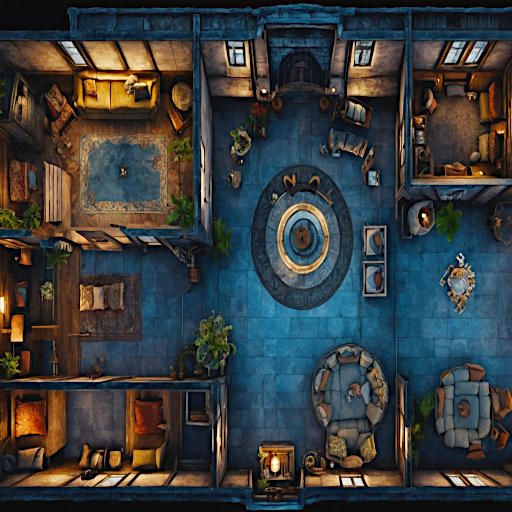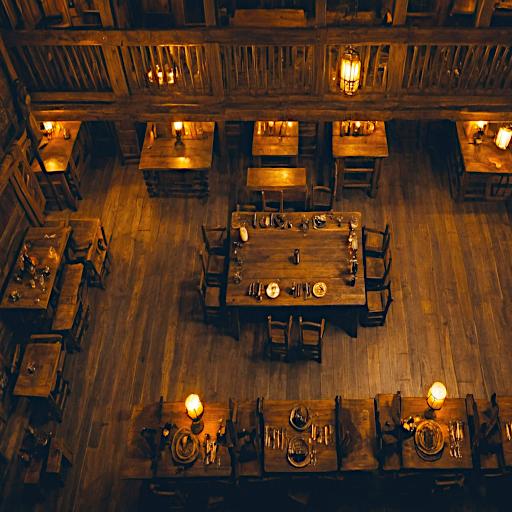Chapter 3 - Combat
Here is an overview of the combat system followed by a discussion on how this system affects game play. Once ready, a PDF link will appear on this page so you can dowload the whole chapter.
How it Works
Grid or No Grid
For melee combat or distances where melee might be involved, a grid is recommended to keep track of distances and facing. Hexes are recommended over squares. Don't worry, you won't be counting squares like in D&D, and you don't have to stand in the middle of the space. An optional movement method for TOTM combat is also provided.
Time Economy vs. Action Economy
Rather than asking how many actions per round (unit of time), Virtually Real asks how much time it takes to perform an action. You get 1 action.
The GM marks off the amount of time required, forming a bar graph per combatant. The next offense goes to the shortest bar. Ties for time cause an initiative roll of the tied combatants.

Initiave and Waves
When you are tied for time with an enemy combatant, then roll initiative to break the tie. Use your weapon's initiative bonus rather than your Reflex modifier. A readied action means your time is bumped up to the start of the action that triggers it, and you gain advantage on the initiative roll. On a critical failure of initiative, roll a reflex and reaction time check (uses your Reflex modifier) to see how much time you lose. On a second tie, both combatants act simultaneously. Neither gets readied action advantages. If both attack each other, roll both attacks and then both roll evade as the only available defense.
Your Wave begins on your first offense after your first initiative roll. All combat passions are now available for use. As you use them, check them off. You may restart your wave after any initiative roll by spending an endurance point. This will remove any penalties that only last 1 Wave and allows you to erase all your tick marks that were checking off passions. You get all your combat passions back in the new Wave. It dismisses any other effects, such as spell effects, if that effect only lasts a wave. Bleeding and energy effects are also applied per wave! You'll likely want to save some endurance to sprint, so don't let yourself get Winded!
Types Of Actions
Each type of action has a speed value that is converted to a time cost through a table. Both values are on your character sheet.
- Non-combat Actions are things like drinking potions, opening doors, and moveing stealthily. The speed is based on your Reflexes attribute. You may make your Free Movement before and after the action.
- Combat actions take your non-combat speed and add +1 if you are combat trained. This gives your Dodge time and possibly other actions, and is the base for weapon actions. You can make your free movement during these actions.
- Weapon Actions take your combat speed and add speed bonuses at specific experience levels. As your weapon proficiency goes up, you get either a Strike/Parry bonus or a Speed bonus, depending on the weapon and it's size. You still get your free movement.
- Fast Actions depend on your attribute capacity. These are always 1 second for humans, but can range from 1.5s to 0.25s. This determines delay times, aim times, power attacks time, and running time. These are the shortest actions that cost time. Free movement is generally not allowed unless it specifically mentioned, such as on a delay.
- Maneuver penalties account for the penalties of being too slow or outnumbered. Every defense takes a maneuver penalty, even "free" defenses that don't cost enough time to measure because they flow into the next action (like parry and evade), but they do cost enough time to affect initiative and future defenses.
For more info:
Movement
The GM may choose to use Tactical maps or TOTM as needed. Typically, melee battles are tactical and long-range combats are totm, but both work. You can even have ranged combatants using TOTM shooting into a tactical area.
Tactical Movement
Typically done on hexes, but squares work as well. The scale is 6 feet, or 2 yd per space. If you use metric, just pretend 1 yd = 1 m and don't convert.
- Free Movement - you can step and turn 1 as part of another action. Turns are 1 side (60° for hexes, 90° for squares)
- Running - Move 2 space as part of a Fast Running Action (SPD). If you have any maneuver penalties, running and sprinting distances are reduced by 1, but you remove 1 maneuver penalty.
- Sprinting - You must be running or sprinting on the previous action to Sprint. Move the number on a rolled Sprint die as part of a Fast Sprinting Action. If you have none rolled, or used them all, you will need to spend an Endurance point to roll some more. Sprint actions are the same time cost as running unless you have a horizontal backbone allowing your to run on all 4s.
- All 1s rolled while sprinting are discarded. Advantages/Disadvantages change how many sprint dice are rolled. 6s can be spent to add your free movement to another die. If you spend 2 6's at once, all dice lower than 6 are discarded. Adrenaline adds your adrenaline level to your number of Sprint dice and allows 6s to explode. All 6s rolled let you add more dice to the pool, which also explode if they roll 6!
TOTM Movement (optional)
- Free Movement is relative, but not tracked. Facing is strictly a GM call.
- Running within the same "zone" (room or nearby area), is a Speed attribute check which determines how long it takes. You will need to roll a second check to "cross zones", and possibly a third to move within the next zone.
- The GM can switch into "yards" at any time, such as when you are getting close to another opponent and might enter melee, or when operating in the closer ranged of your weapon (< 3 dice range penalty). Just use the tactical movement and double the number of spaces to get yards. The GM tracks distances until someone pulls out a mini or token and a map.
- Sprinting means you spend an endurance point and roll an advantage on running checks until you make spend time on a non-movement action. If being chased, switch to montage rules and handle narratively.
Positional Penalties
Different sized weapons take penalties at different ranges. Pole arms may have great reach, but really suck close up. Some weapons, such as a quarterstaff, allow you to reposition your grip for use at a wider range of distances. No action is required, there are just fewer penalties.
In addition to normal melee range, you also have "close" range, such as hand to hand combat. For most melee weapons, you can't use your free movement while attacking at this distance. You will need to use a reflex action take your normal free movement. This condition also applies when in a confined space or entangled in any way.
Closer than that is grappling range, you use knees, elbow, and headbutts. At this range, a reflex action can be used to change range. If actually grappled, you need to win a Wrestling check to get out of the grapple before you can move.
The winner of any melee "exchange" (in melee range or closer) is allowed to move closer or further (if closer than melee) without spending any time. These rules don't let you step out of melee range. You use regular free movement for that. If I attack you with my dagger, and do damage, then I "won" that exchange. If I was in melee range before, I must have stepped in to hit, so I can choose to attack from "close" range from now on. If I was already in close, I can move into grappling range if desired. If your opponent has a parry that beats your strike, they can use that to step in or out and change distances. On a tie, neither opponent can change the distance.
When using a combat grid, move your token half a space (1 yd) closer or further. Half-way into an opponent's space is "close" while being in the space is grappling range.
Being on an opponent's primary-hand side gives your opponent a disadvantage, while being at a rear flank is two disadvantage dice, and directly behind is 3. Range will add additional disadvantage dice. Remember that advantage and disadvantage dice will "swing" and generate an inverse bell curve when combined (See Chapter 1).
Offensive Actions
The most common are Attack, Aim (ranged/thrown attacks only), and Power Attack. An attack is a weapon skill that involves the [S]trike bonus of your weapon. A power attack adds your Body attribute modifier and any Body capacity modifier to the attack. This costs a Reflex action on top of your weapon action.
A power attack broadcasts your intent, giving your opponent extra time to ready a better defense, while putting yourself in a worse predicament for mounting your own defense or quick combos. All this is reflected in the additional resources used for the attack. You can only add your Body attribute to a roll if you are not Winded (Endurance total above 0). If your attribute capacity is 1, you can't power attack.
A wild swing adds an advantage and disadvantage to your attack.
A feint is a reflex action.
Ranged Attack
A ranged attack is just like a melee attack except that additional ranges are available. Maneuver penalties apply to ranged attacks unless you take a Delay action to reset the penalties (imagine shooting a bow while dodging). After making a ranged attack, keep one of the dice. This will be an "aim" die. You get an additional aim die each shot as a sustained fire bonus to a maximum of your Mind attribute modifier. You must maintain line of sight with your target to keep this bonus. You can not aim at a target you can not see! If the target ducks behind cover, you switch targets, or if you spend time on any action other than a delay, you give back all sustained fire dice.
Aim
You can take a mind action (usually 1s) to Aim rather than releasing a round/arrow. You gain 1 aim die to use as an advantage die on your attack and your offense is over. You may take your usual free movement and single turn while you aim, but can not move any faster. You can attack with that advantage at your next offense, or you can keep aiming!
Defensive Actions
The usual defensive maneuvers are Evade and Parry. You can also perform these as actions, Dodge and Block. Actions cost time, and time is precious! A "hard defense" (anything that costs time) must begin before the time of the attack against you! You can still declare the attack after you see the roll, but your time will need to start before the incoming attack ends.
Rolling a defensive maneuver incurs a maneuver penalty, making your next defense more difficult and increasing the risk of critical failure until you get another offense. It also penalizes initiative rolls (including reaction time rolls and binds) and ranged attacks.
On a Block, you add the skill's related attribute and any capacity modifier and this costs a weapon action's worth of time and you give up your free movement, but this makes you vulnerable to binds and shields can provide cover (or cower if you spend a non-combat action) as part of a block.
Bind
On a tie between offense and defense, roll a Reflex & Reaction Time roll. These rolls have no critical failure and use the Reflex modifier, not the weapon's initiative. You lose time according to the value rolled. If an opponent has a weapon at least 1 size category smaller than the other, that combatant gets an advantage on this roll. You may use Initiative passions on this roll. The "Half Step" passion allows you to step in (or step out) during a Bind.
Shield Cover/Cower
When blocking with a shield, you gain cover from all frontal attacks. Bucklers offer no cover, small shields a cover of 1, large shields a cover of 2, and tower shields a cover of 3. If you maintain the cover and try to attack, your attack suffers disadvantage dice equal to the cover number, but this can be reduced by passions.
You can "Shield Cower" instead of a Shield Block. This works as a non-combat action and can be used on a readied action to get the cover bonus immediately. When you cower, you are considered kneeling/crawling, you give up all free movement, you may not attack, and cover increases by 2. Area attacks have their X value decreased by the original shield cover value. You can't cower behind a buckler!
Damage
Base damage is offense - defense. If this total is 0 or less, your defensive maneuver succeeds and you are not hit. Otherwise you are hit and the difference is your base damage. This damage is modified by your weapon's [D] value. D values are +1 for sharp edges or spikes, and another +1D for 2 handed attacks.
Armor
Armor can convert some lethal damage to non-lethal damage. The amount is equal to the armor's AD value. A weapon may have "Armor Penetration (AP)" capabilities that reduces the AD of armor. Wound conditions are based on lethal damage for lethal attacks and total damage for non-lethal attacks. Combat training saves are either Typically Bludgeoning weapons are +1D.
Ammo
Ammunition is kept track of by using an extra dice bag as a magazine or quiver. The dice inside is your ammunition. Take one out and use it as part of your attack roll. If you double-tap (requires a semi-automatic and the "DoubleTap" passion) or fire a 3 round burst (requires a capable weapon), then remove the number of rounds fired from the ammo bag. Any extra dice from additional ammunition fired become advantage dice.
Wounds
Every creature has a Damage Capacity (DC), used to determine the severity of a wound. A minor wound is 1-2 points for everyone. A serious wound starts at your DC, which is 6 for a human. This means 3-5 points is a major wound, and 6 or more points is a serious wound. A critical wound does damage equal to your max hit points or more in one attack.
Conditions from wounds are determined by the type of attack and the wound level. More serious injuries can affect initiative rolls and more.
Basic Combat Training (BCT)
If you've taken any wounds since your last offense, you must roll a BCT save to act. The degree of failure determines how much time you lose from pain, injury and fear. If you've only taken minor injuries and you have at least primary combat training, then you can ignore this check. NPCs also use this roll for morale checks, taking into consideration the ratio of combatants on each side.
BCT also affects initiative. Roll your Reflex dice or BCT dice, whichever is higher. The capacity of the roll (how many of the highest dice you keep) is equal to the lower number. Thus, a human without combat training is rolling 2d6 and keeping the higher die, while with combat training, you would keep both dice. This drastically reduces initiative, and increases the chances of losing significant time due to surprise and confusion (a critical fail).
Once you hit 0 hit points, you take a critical condition which causes BCT saves to be resolved as Body saves instead. Your training no longer matters. And failed Body saves can lead to incapacitation and death. You do not automatically fall unconscious, there are no rolls to make unless you wish to act. Roll the save (and possibly die on failure) in order to keep fighting.
Critical Conditions
A critical condition increases your critical failure range for all rolls. However, it also causes an andrenaline burst that grants advantages in things like Sprinting or Perception. You can attempt to turn this response from a defense response into an aggresstive response. Other subsystems integrate with the adrenaline system to provide for dramatic feats of heroism when defending the things that matter to you most! This also helps avoid death spiral problems!
Conclusions
Consistency
One of the big problems I saw in D&D and other systems was that results were all over the place. Even when you rolled a high attack, you could roll a low damage. What makes this system work is that consistency of rolls is achieved through tightly controlled probabilities formed by the basic system of Chapter 1.
Active Defense
A number of systems want to keep the number of rolls down or have only player-facing rolls. However, people love to feel like they are actively defending themselves. Opposed rolls scale damage to each hit rather than using a "to hit" ratio to scale damage over dozens of rounds. Plus, active defense removes the need for escalating hit points and tons of mechanics that come from that.
Offense - Defense
Calculated damage doesn't just reduce time spent rolling dice, but basing damage on the combatants skill levels means that every possible advantage or disadvantage to your strike roll changes your damage output. Wound severity levels mean that its better to do large amounts of damage rather than paper cut your opponent to death.
If a well-hidden opponent shoots from concealment, and the target fails to detect the attacker, then they don't get a defense roll. No special sneak attack ability is needed to do massive damage, just don't let anyone see you!
This also means that those with higher skill levels do more damage to lower skilled opponents, but the proper usage of tactical options can be much more effective than relying on numbers! This is especially true since you don't get strike bonuses every skill level. Sometimes you get a parry bonus, or effective range increase, or something else, reducing the disparity between combatants of different levels. You don't generally get more hit points.
Passions
Passions are covered in the next chapter. Passions are earned from Styles. Certain skills, like Basic Combat Training, come with a style that is represented as a tree of "passions." Combat styles also go to world building and defining cultures. You can assume that tribal communities will usually share a style. Combat styles form the heart of the martial arts system as well!
Passions are sometimes limited to a certain number of uses per "wave" of attack. Your wave will normally start with an intiative roll, although not every initiative roll restarts a wave. Some passions, like Second Wind, will immediately begin a new wave. When a new wave starts, erase any marks used to keep track of used passions.
Tactics
You'll want to constantly step to your opponent's primary side in melee while preventing them from doing the same to you. Step and delay (or ready an action) to make them come to you. Use power attacks when you see an opening in your opponent's defenses (when they have a maneuver penalty) or when you need to prevent an enemy from attacking your ally. The power attack gives them the time and incentive to block or dodge, which costs time, time they can't use to attack your ally! You can also use your passions to set up combination attacks that exploit specific disadvantages.
Speed
Quick resolution is a popular goal. By removing the action economy, Virtually Real drastically speeds up resolution. Defensive actions engage the players between turns, and when you get your next action is deliberately kept elusive, ensuring players pay attention! The most common feedback during testing was "It's on me already?" because things really move! And the low hit points, which rarely go up, stop the super-long slugfests of massive attrition. You'll know fairly early on if you are out-matched and need to run!
Happy Hunting









